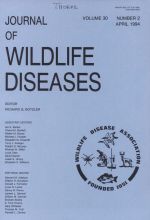We evaluated the susceptibility of laboratory reared adult and infant white-footed mice (Peromyscus leucopus) to a known pathogenic isolate of Borrelia burgdorferi (N40). Two-month-old and 3-day-old Peromyscus were inoculated intradermally with 106 to 107 spirochetes. At 21 days for adults or 30 days for infants post inoculation, mice were killed, and tissues were cultured for spirochetes and examined microscopically. Based on serology and culture, adult mice became infected but did not have any gross or microscopic lesions. Mice inoculated as infants became infected, and also developed carditis and multifocal arthritis. Contact transmission between inoculated infants and their naive mothers was not observed. Age at inoculation appeared to be a critical factor in inducing Lyme borreliosis lesions in Peromyscus leucopus, as in other species.
How to translate text using browser tools
1 April 1994
EXPERIMENTAL BORRELIA BURGDORFERI INFECTION IN PEROMYSCUS LEUCOPUS
Kathleen D. Moody,
Gordon A. Terwilliger,
George M. Hansen,
Stephen W. Barthold

Journal of Wildlife Diseases
Vol. 30 • No. 2
April 1994
Vol. 30 • No. 2
April 1994
arthritis
Borrelia burgdorferi
carditis
Lyme borreliosis
Lyme disease
Peromyscus leucopus
spirochete




